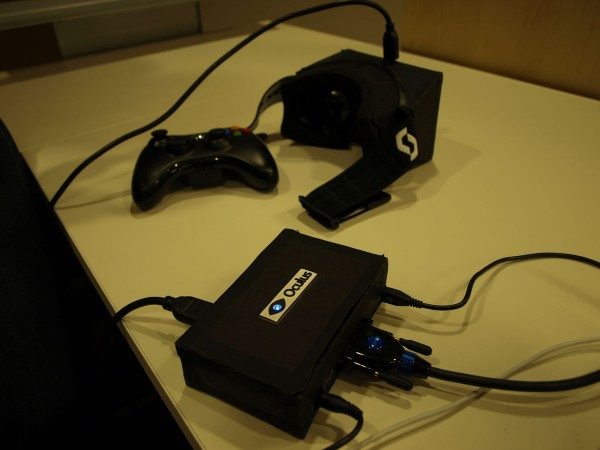Time for a catch up on the latest Oculus Rift news. In this edition of ORNB we look at an Oculus Rift review of a prototype developer kit and learn details about the new 7″ display that the head mounted display is now using. Just learning about the Oculus Rift HMD? Click here to get caught up.
Prototype Oculus Rift Review
The latest hands on with the Oculus Rift developer kit prototype comes from Stuff.tv who recently visited Oculus Inc.’s offices in California to spend some time with the unit. We’ve heard most of what was reported prior, but one interesting thing stands out:
We tested the Oculus Rift on a MacBook Pro running Doom 3 and a newer, more advanced game engine that Oculus asks me not to identify (they’re still in commercial discussions). [my emphasis]
So far we know the Oculus Rift SDK will work with both Unreal and Unity engines; there aren’t many hints as to what this other ‘more advanced game engine’ might be. My best guesses would be either Crytek’s CryEngine or possibly Valve’s Source engine, but it should be noted that there’s not much to go on at this point.
Stuff.tv calls the prototype, which adapts a pair of ski goggles, “super comfy,” an attribute which hopefully carries over to the final developer kits. The review also says that the experience of playing is “simply stunning.” Regarding head tracking, Stuff.tv says the following:
Response time is almost perfect, with every twitch of your head reflected immediately in the world – it really is as if we’re actually inside the game rather than just watching or playing it. The experience of floating through the virtual environment is so natural that it’s easy to forget that we’re still sitting in an office chair rather than roving through an industrial landscape hunting zombies.
One more interesting bit from Stuff.tv’s piece. They quote the “final version of the Rift” (Oculus Rift consumer version / Oculus Rift 2.0) as being “due in 2014.” The last official word we heard regarding the consumer version of the Oculus Rift was that they hoped it could be done by 2013. However, with the Rift being recently delayed 3 months, a 2014 launch for the Oculus Rift 2.0 does sound plausible — we’ve got word out to Oculus to confirm.
New Screen Details
In the previous update from Oculus Inc. the company said that they have moved from a 5.6″ screen to a new 7″ screen. The change was made because the 5.6″ screen had been recently discontinued. 7″ is pretty big and adds 30 grams to the weight of the unit, but the company says that the new display is better in areas that are important to a virtual reality headset despite the resolution being the same (1280×800).
Pixel Fill
According to the company, the new display has a better fill factor which means that there is less space between each pixel. This reduces a display issue, commonly refered to as the ‘screen door effect’, which makes it appear that there is a tiny black grid over the screen. According to the company the screen door effect was quite prevalent with the old screen due to the warping optics in the Oculus Rift. They say that the new display has a higher fill factor and that the screen door effect “significantly reduced, resulting in a better looking image.”
Response Time (AKA Switching Time)
Response time indicates how long it takes for a pixel to change from one color to another. A slow response time means that fast moving images can show a ‘ghosting’ effect where it seems like on-screen objects are leaving faint trails. Slow response time can also make moving objects look blurry. Switching time is even more important in VR games than normal TV or movies because the world is constantly moving around the player as they move their head. From Oculus Inc.:
Our old panel begins switching colors very quickly, which was good, since it reduced the latency between movement and the image responding. However, it’s weakness was that it took a very long time to fully switch colors. This sometimes resulted in motion-blur effect as the frames switched, especially during quick movements of the head.
Our new 7” panel has a switching time that is about twice as fast! This makes a big difference in the perceived responsiveness of the system and helps alleviate the undesired motion-blur.
Palmer Luckey, founder of Oculus Inc., says that the company measured the switching time of the panels with a high speed camera.
Contrast Ratio, Color Accuracy, and Latency
The company further notes that the new display’s contrast ratio is “greatly improved,” which will bring better visual performance to dark games (like Doom 3: BFG which comes with the Oculus Rift for Kickstarter backers). Color accuracy is also improved over the older display as is brightness which makes for brighter and potentially more realistic scenes. More from Oculus Inc. regarding latency:
We’ve also changed our drive electronics! The control box is attached to the headset with a thin and durable cable carrying video, USB, and power. The box contains a custom control board that we designed to minimize video latency. It has easily accessible buttons for contrast and brightness adjustment and it’s much smaller than the control boxes we’ve been showing with our prototypes.
That’s all for now. Looking for more info on the Oculus Rift HMD? See all of our coverage.










